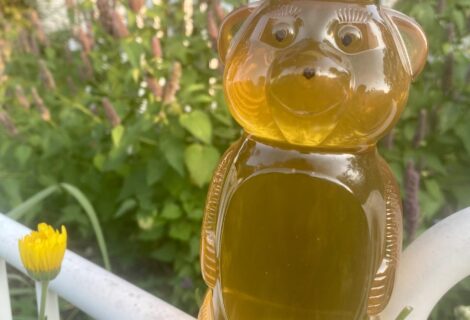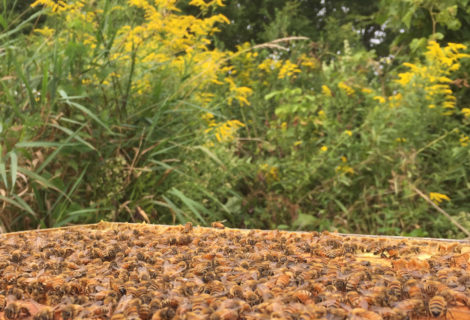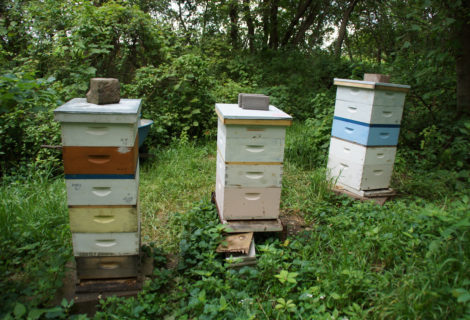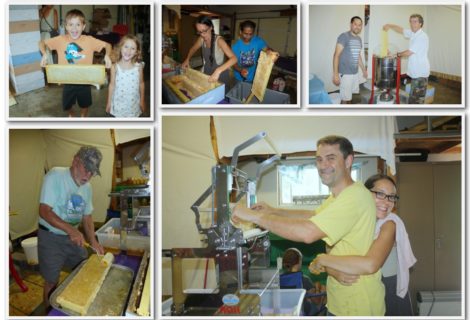New Packages and Splits
Our 2016 season colonies are off and running! They are not all queen-right yet, but it’s something we’ll be monitoring when possible as we go along. Here is Aidan helping me prep and level the hive stands near our house in Minnesota.
On April 15, I was able to get off early from work, and pick up our 7 packages from Assisi Heights in Rochester. They were shipped to The Bee Shed from their California supplier and the packages really seemed to be in good shape. Very few dead bees and the queens were all walking around in their cages. I installed two of them at our place in Marion, and then off to Iowa with the remaining 5. One is for my dad, who is going to be keeping his own colony this year. The other 4 we installed in our bee yard on their property. Hauling them in the trunk of my car is pretty convenient. I only saw one bee manage to make it into the driver cabin.
The new queens are all Italian this year. Since I was able to stay the night in Iowa, I tried a different method this year. Rather than shaking all the bees from a package into the box, I removed 4 frames from the box and set the package in that space with the feeder can removed and the queen cage wedged between a couple other frames like normal. The next day, I opened up the hives and removed the package box and replaced the 4 frames. Most of the colonies had released the queen already by that point. It worked well – didn’t have a mass of bees flying around from all the shaking and didn’t have to spray them with sugar syrup. What we did do is have a number of frames of honey/syrup ready to go in the brood boxes of the new hives – from dead-0uts during the past winter. I think that was also a plus though the wildflowers were already starting to bloom in the woods by this point. Four of my 6 packages I put in double medium boxes and the remaining 2 I put in single deeps.
On April 16, Jana and I were also able to go through the over-wintered colonies (15-C, 15-D, and 15-E). 15-C was the strong one with a Carniolan queen going gang-busters. It had been consuming a lot of sugar syrup and was 4 mediums full of bees. I rotated a few of the boxes and put on an extra box of honey/syrup frames plus a few empties. The intent was to check on it in another week and hopefully split it. The photo below shows a lot of bees flying plus the 4 boxes split in half, all loaded with bees.
Colonies 15-D (Carniolan) and 15-E (Italian) were weaker with a smaller cluster of bees each. Before going through them, they were composed of a deep followed by 3 mediums on D and 2 mediums on E. We consolidated each of them to two medium brood boxes, and replaced their bottom boards with new ones. They had a lot of dead bees still on the bottom and the colonies were too weak to clean them out. Hive E, especially, had its bottom brood box practically plugged with dead and molding bees. From the look of the bottom board and top cover, it certainly seems to have had a more serious moisture problem compared to the other hives. It did have a small brood nest with eggs and we saw the queen though, so we let it be to see how it would fair.
On April 23 & 24, I checked on all the colonies again. I love seeing new comb being drawn by the fresh package colonies:
Colony 15-E seemed to be in similar shape. 15-D however, did not have eggs and the bees were building queen cells with larvae inside. Based on the young age of some brood, it wasn’t like I had squashed the queen during box consolidation the prior week. But its not uncommon to have year-old queens start failing.
I left this one alone to see if they would be successful in new queen rearing, and proceeded to split colony 15-C into 15-C1, 15-C2, and 15-C3: A 3-way split with 2 medium brood chambers each. At this point, all 5 mediums of the original colony were bursting with bees and brood. It took a while to go through them, dispersing frame-by-frame, into each of 3 new hives. I never saw the queen and it appeared that she might be failing in this colony as well. Although there was loads of capped brood, I saw very few eggs, and was fortunate to spot clusters of eggs on 3 frames that I could could use for the 3-way split.
We left one of the colonies in the original location, and the other two we put on the tractor loader, taped the boxes together and moved them to their hive stands several hundred yards away. Most of the original colony foragers that were in the field will return to the colony in the original location. For those few foragers that were inside the two moved hives, we can just hope they will re-orientate themselves to the new location and find their way back. We laid some dry hay stems against the entrances to hopefully give leaving forager bees pause and think, “hey, maybe I’m not where I used to be.” Because if they rush off without re-orientating, then they will not find their way back.
I was not able to purchase new queens before doing this, so these are what’s termed “walk-away splits”. They may be able to raise their own queens, and if they do, they can survive and have a break in their brood cycle before the new queen starts laying again. This can drastically cut down the mite population and result in a healthier colony without needing specific mite treatments, at least yet. On the other hand, it can be 6 or 7 weeks before new brood starts hatching from the newly raised and mated queen. This still gives the colony time to get strong before going into next winter, but it does not bode well for honey production, especially with the basswood bloom expected to start in June. So I still am considering purchasing queens from a local place when their next shipment comes in and seeing if one or more of these colonies act like it would accept a new caged queen before releasing it. If I went that route though, it’s advisable to remove any queen cells in progress by the colony, and the weather over the next several days looks pretty iffy for that.
One glorious sight through this process was seeing the spring bloom already in progress in the woods. The picture below shows some of the wildflowers! The plums and willows were blooming as well. For the time being, our colonies have a lot of forage opportunities, at least when it warms up again 🙂















Recent Comments